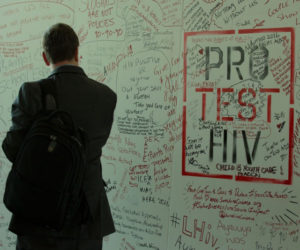Why Is HIV Still so Widely Misunderstood?
Post by Ida Jooste, Global Health Advisor at Internews and Callie Long, Media Development Practitioner*
South Africa is now implementing “test and treat” – where every HIV positive person is placed on anti-retroviral treatment (ART), regardless of their CD4 count. The policy follows the announcement of new guidelines for HIV management by the World Health Organization (WHO) in December 2015. Journalists need to tell this story, because in theory, “test and treat” may significantly reduce new infections.

HIV testing is the first crucial step. Credit: André Smith
The South African government says it hopes to increase life expectancy in the country from 63 to 70 years of age. “In the long run lives will be saved and money saved by this early treatment,” says Joe Maila, spokesperson of the Department of Health in South Africa. But how do we bring theory closer to reality, and how do we make “the long run” arrive sooner? – because we need to. Especially as South Africa is the country with the largest number of people living with HIV in the world and the country with the largest anti-retroviral program.
Science vs. Traditional Belief Systems
David Dickson, a professor of sociology at Wits University in South Africa, in 2015, raised an interesting question related to HIV in his country – “why, after almost 30 years of public health messages, do alternative, non-scientific explanations of AIDS continue to circulate?” His commentary, “Why scientific AIDS explanations struggle in townships” highlights the puzzle associated with the “frustrating stubbornness” of the disease, which, in spite of the large number of people accessing treatment, still shows up as the third largest killer of people in the country.
On any given day, around the world, millions of dollars are poured into public health education programs, bolstered by research that confirms that evidence-based communication programs are increasing people’s knowledge, shifting their attitudes and cultural norms, and changing their behavior.
Dickson’s research (his full commentary is here), focuses on AIDS beliefs of people living in townships, raising a point that these communities live in a geographic area which he describes as “a continuing spatial legacy of apartheid.” Using an ethnographic approach, he worked with township residents living with HIV, exploring the way in which people weigh and manage competing explanations and beliefs in “often grim situations.”
Dickson’s article brought to mind Lisa Cobb’s cross-posts on HC3 and the Ebola Communication Network. In one of her blogs, Anthropology and Ebola Communication, Cobb points out the need to conceptualize behavior through an anthropological lens –ask why people do what they do. Journalists are also concerned with the question of why and that it is the heart of every story.
When “test and treat” guidelines were first released by the WHO, clinicians and epidemiologists expressed both support for it and caution against it. Field experience has shown that some existing treatment programs in developing countries fared poorly at retaining patients in care after diagnosis, or starting people on treatment before they become seriously ill. All the more reason to ensure people know enough about the benefits of “test and treat” and that practitioners work hard to remove barriers to the uptake of services and behavior change.
Journalists have to ask why – despite the fact that ART works –people may not seek “test and treat” services. Internews supports journalists in their local contexts to bolster their ability to report accurately, especially when it comes to public health. We worked with and trained journalists for years in Kenya as well as journalists reporting the HIV epidemic in India, Ethiopia and Nigeria and partnered with HC3 to work with journalists in Liberia in the Ebola response. They now better understand the science and the people aspect of the story, are grounded in their own communities, and can focus on trends and patterns of behavior that stem from stigma and distrust.
At the World AIDS conference in Durban, academy award winner Charlize Theron told delegates: “HIV isn’t just transmitted by sex — it’s transmitted by sexism, and racism, poverty and homophobia. If we are going to end AIDS, we must cure the disease in our hearts and minds first.” Journalists play an important role in doing just that.
Her words echo the findings of a Gates Foundation survey among a select group of stakeholders on how to accelerate efforts to reduce the global incidence and burden of HIV in 2016 and beyond. One of the recommendations is that we need to be much more curious about people and the challenges in their lives: “In order to improve people’s access to and utilization of crucial interventions, it is important to gain a better understanding of people’s lives and the challenges and barriers they face on a daily basis […] Ultimately, there is a need to meet people where their lives are. This is essential to help understand why infection rates are so high, and help understand why it’s hard for some people to access and maintain treatment.”
New HIV infections have been decreasing worldwide, however, much more needs to be done. “Test and treat” can change the course of the epidemic and journalists with an ear to the ground can tell the people story of why creating an AIDS-free generation remains elusive but is attainable.
This post, written by Ida Jooste, Global Health Advisor at Internews and Callie Long, Media Development Practitioner, was adapted from this version, which appeared on Medium.com.







Leave a Reply
Want to join the discussion?Feel free to contribute!